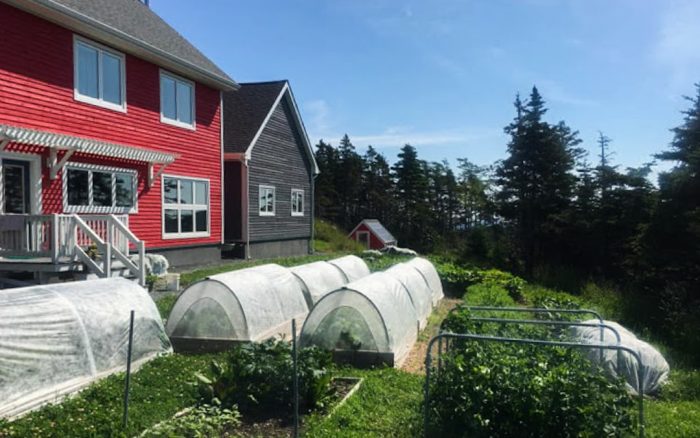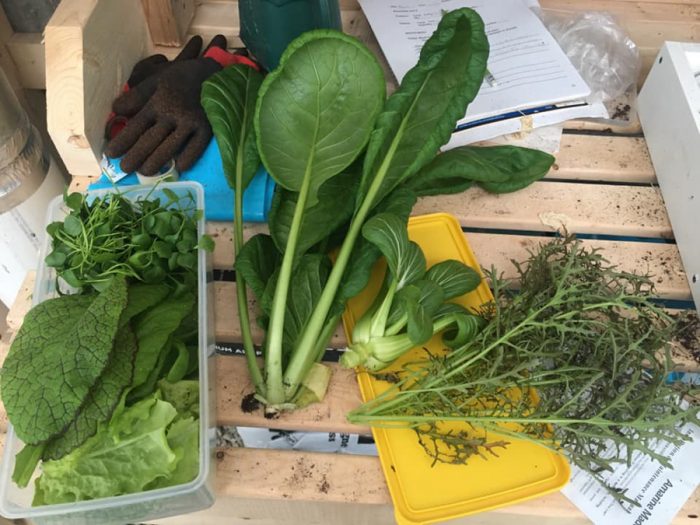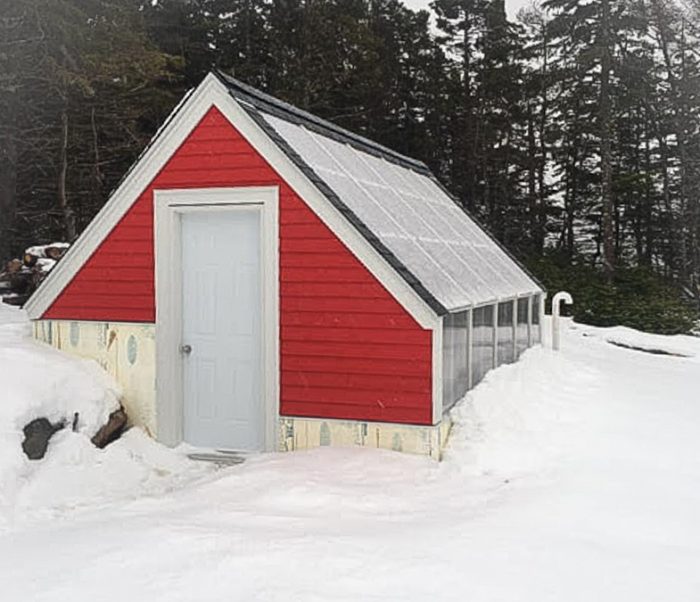
Editor’s Note: This is the last installment in a series of posts by David Goodyear about the construction of his new home in Flatrock, Newfoundland, the first in the province built to the Passive House standard. You’ll find his complete blog here and a list of his other GBA posts at the bottom of this page.
So, a lot has happened! The greenhouse is now complete. My regular blogging frequency prevented me from making headway with various projects. It was a very busy spring, summer, and fall in 2019.
Working, planning our crops, maintaining a vegetable garden with weeding and regular succession plantings, and building a greenhouse all proved to be an exhausting task. Funny, foreseeing all of the other stuff to be done, I was on the fence about building the greenhouse this past spring. But I decided at the last minute that I would move ahead with the project. Now that it is finished I am glad that I did. It turned out to be a great project with great dividends.
Completing the greenhouse
Unfortunately for readers, I don’t have many pictures to share that illustrate details for air sealing and insulating, or how I designed the air barrier, or how I vented the rainscreen and roof. But I do have results!
Growing in an insulated subterranean environment does work. But it only works well if you choose the right crops. When designing the greenhouse I opted for minimizing the number of holes in the envelope and I made it pretty airtight. I haven’t done any blower door tests, but you can feel the pressure differential in your ears when closing the door, and sometimes the door springs open if it doesn’t latch immediately.

Early in the fall (September), the greenhouse was hot. That’s not surprising given the high level of insulation and large amount of glazing. I did run a fan to help keep the building cool and the GAHT system (what I call a climate battery described in this post) was almost always running on sunny days. Luckily, we don’t have many sunny days. That being said, it was manageable, but growing in the middle of summer may turn out to be tricky. The University of Minnesota Deep Winter Greenhouse producers guide recommends closing the structure up for the summer and letting it bake. The inside temperature can get high enough to kill any soil borne diseases and rid the structure of any pests. I may decide to do this when the summer comes.
Choose crops carefully
The fall proved to be a great season for growing in a deep winter greenhouse. Planting crops that can handle some residual heat and still be content proved to be very successful. We ate crops from the greenhouse every day. Baby salad greens are a great producer. Komatsuna, mizuna, mustard, and arugula were growing right up till December. However, after October 31, the days are less than 10 hours. In our climate along with the lack of sun, 10 hours means that although the temperature in the greenhouse is still good for growing, many of the plants are not able to actively grow.
Growth is ever so slow but we are still able to pick about 10 ounces per week. This is where full grown plants are beneficial. They are mature enough to ride the darkness through to longer days. We planted enough in the beds to get us through to February. Along with our cellared vegetables, we no longer purchase vegetables at the supermarket.

February is cold and can hit -15°C. However, the days are longer and typically there is more sunshine than in December and January. So I am expecting that production will pick up again soon.
As of January 6, the greenhouse is still above 0°C with no active heating despite 8 1/2-hour days. So far we have been able to a meet 10°C differential with respect to the outside overnight. For example, today it is -6°C outside (complete cloud cover) and the greenhouse is at 4.2°C. As of now, neither the GAHT or the 4 kW heater has been activated by low interior temperatures. This is pretty amazing.
We live in a province that produces less than 10% of the food consumed. Production could easily be ramped up here by using earth sheltered structures. Growing tomatoes and cucumbers in the middle of a Newfoundland winter would be a bad idea from an energy use point of view, but green vegetables could easily be produced at these temperatures. The absence of light appears to be the real limiting factor but this could easily be amended with low-energy LEDs with the right wavelengths.
With current production levels, vegetable prices, and the rate of our consumption I expect the greenhouse will pay itself off in about 5 years.
A report on our Passive House
We are now into the second year of living in our house. During the first year there were issues with humidity, through the summer and even into the winter. This year there has been a decline in moisture.
During the summer we ran our Fujitsu 9RLSH as a dehumidifier. This proved to be quite effective at maintaining comfort through the summer. Moisture levels are now above 45% but less than 50% on average. This has made the house really comfortable during the winter.
Other than the balancing issue I was having with the ERV system, nothing really has changed with ventilation or our water usage patterns, I am guessing that a major contribution to our humidity problem may have been due to construction moisture. I have read several articles stating that construction moisture can lead to high humidity in super airtight homes.
We use our wood stove regularly. I typically fire it once every two or three days, depending on weather and depletion of the thermal storage tank. The living areas get pretty warm during use (23°C or 73°F).
I will note that the stove’s quick insulation kit does work quite well. It insulates the stove down to an output of about 2.5 kw. Without the insulation kit, the wood stove would lead to a really uncomfortable space. If the stove were uninsulated, 5 kw would be much more than the heat load of the whole structure on a cold day. It is a good thing we purchased the option. The heat load of the house is small enough that the stove is producing hot water much quicker than the house could dissipate it. A couple of armfuls of wood are enough to heat the house and provide hot water for a couple of days.
Our energy use has been great. The consumption for the year was about 13,000 kWh, for a total of $1,725 taxes in. Given our rate increases that is pretty good. PHPP estimates came in at 10,300 kWh but included a heat pump water heater. Those estimates did not include the garage, which I estimated independently to be about 5,500 kWh if maintaining a temperature of 18°C (64.4°F). The temperature is more like 15°C (59°F) and I can still work comfortably.
Our previous house used electricity and propane. The total yearly bill (projected to today’s rates) was $5,600. That’s a savings of $3,875 annually. Pretty amazing. Passive Houses work. This year our bill should be lower given the wood heating. Right now I have enough fuel cut from my own lot to last a couple of years.
An end to a long ride
The past few years have been a real roller coaster. I set out on a three-year plan to design and build a low-energy house, provide our family with good homegrown food and food security through a backyard garden farm and a traditional root cellar.
The greenhouse was really the final piece of the puzzle; providing healthy, pesticide-free, organic vegetables during our long, cold winter.
It is likely that this will be my last blog post, but the blog will remain a part of the internet. I hope people find it useful. It was a great process to track my progress through this project and was a great way to log my decision-making for future reference.
Later….until I build another…I’ll be sure to ask my wife before I start.
BLOGS BY DAVID GOODYEAR
Essentials for a Winter Greenhouse
Thoughts on a Winter Greenhouse
Blower Door Test Comes Up Roses
Laying Out the Mechanical System
Framing and Insulating an Interior Service Wall
Foam Sheathing and Window Details
A Final Design and Energy Modeling
An Introduction to the Flatrock Passive House
Weekly Newsletter
Get building science and energy efficiency advice, plus special offers, in your inbox.















11 Comments
Congrats! Your posts are inspiration and a great example of the fruits of one's labour.
Funny, I have had many people say similar. The main purpose of the blog initially was to document progress. It has turned into something much more. It appears that it is always being accessed by somebody. My hope is that people find it useful. Thanks, DJG.
Thanks for your contributions to GBA, David. And I agree with Jaccen, your effort and outcome are an inspiration. Maybe you'll write an update post after another year or two living in the house and growing food...we'd love to share it.
No problem Brian the pleasure was mine, and who knows what the future holds here in flatrock!
David,
Thanks for sharing the journey, I've enjoyed your blogs immensely.
Malcolm, I’m glad I had a chance to share it and glad you enjoyed it!
David,
Having gone through my own build, I know how much time it can consume- especially as one seeks not to lose his day job. We are all grateful for you taking the time to share your wisdom through your blog over the years. It has been a helpful resource for me and others.
Best of luck enjoying the fruits (or leafy greens) of your labor!
Thank you again,
Rick
Thanks Rick, it did take a lot of time but given my sleep deprived state I had another 3 hours a day to spare!
We are enjoying fresh vegetables all year and it’s great! We have many experiments to try....tomatoes in March maybe?!?
Later
DJG
Another thank-you from me. We are on the opposite coast from you, but many good common principles still apply here in the rainforest.
I enjoyed your writing - I echo the request for an update some day in the future.
It's been three years since David Goodyear's blog series Flatrock Passive came to a close. David's house, the first built to the Passive House standard in the Canadian province of Newfoundland, was complete. He had detailed construction in a dozen and a half posts, covering everything from foundation to blower door test. But for David, the story was really just beginning. He wrote recently to bring us up to date on what's been happening since then, much of it focused on producing his own food for year-round consumption. In a climate like his, that's no mean feat. He's explained all of this in a new post, and for all those GBA readers who followed the story originally, you'll find a progress report here: http://flatrockpassivehouse.blogspot.com/2023/03/five-years-have-passed.html.
Thanks Scott, It really was only the beginning. We've accomplished what we set out to do and yearly iterations are adding so much more. To be honest, building this house on this property and making it a "home" was the best thing we ever did.
Log in or create an account to post a comment.
Sign up Log in